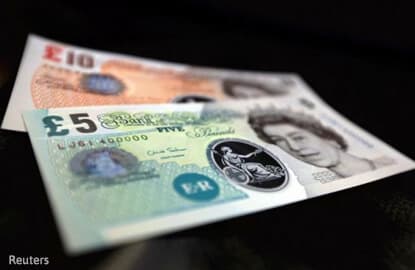
TOKYO (Oct 7): The pound plunged as much as 6.1 percent against the dollar, the biggest decline since the day the U.K.’s Brexit referendum result was announced, in a move that traders struggled to immediately explain.
Sterling sank as low as $1.1841, according to data compiled by Bloomberg, the lowest since March 1985. The pound quickly pared the drop, trading 1.1 percent weaker at $1.2472 at 9:26 a.m. in Tokyo. Traders questioned whether computer-driven orders had triggered the plunge, exacerbated by a lack of liquidity in early Asian hours, while some saw the possibility of human error, or a so-called “fat finger.” Others pointed to a Financial Times article citing French President Francois Hollande as saying the U.K. must suffer the consequences of leaving the European Union.
“What we had was insane - call it flash crash, but the move of this magnitude really tells you how low the currency can really go," Naeem Aslam, chief market analyst of Think Markets wrote in a note. “Hard Brexit has haunted the sterling."
The pound dropped as much as 6.5 percent versus the euro and was down 1.1 percent at 89.37 pence per euro. The FT reported that Hollande, speaking in Paris at a dinner attended by EU officials, urged the bloc to lead tough negotiations with Britain to avoid contagion and protect the fundamental principles of the single market.
“It looks like it was a algorithm-driven flash crash triggered by a Financial Times article based on French President Hollande’s speech on Brexit,” said Angus Nicholson, a markets analyst in Melbourne at IG Ltd. “Given low volumes in the Asian session, it would have forced other algorithms to join in and magnify the fall.”
The drop versus the dollar could be due to an erroneous order and flows related to stop-loss orders or options, given dollar-yen or euro-dollar aren’t moving much, according to Toshihiko Sakai, Tokyo-based chief manager of foreign-exchange and financial products trading at Mitsubishi UFJ Trust & Banking Corp.
“It’s a timeslot where you often see sudden moves, but it looks like there were moves to cut losses,” said Tomoichiro Kubota, a senior analyst at Matsui Securities Co. in Tokyo. There were no major new fundamental changes, but “it looks like there was selling that honed in on a time of day when there’s lower liquidity.”
Hard Brexit
Leaving the EU has been the main topic at the ruling Conservative Party’s annual conference this week, where U.K. Prime Minister Theresa May seemingly moved closer toward a so-called hard Brexit that would restrict access to the European Union’s single market so that the government can control immigration. Sterling has tumbled since May’s speech on Sunday, accelerating losses as she was said to take the view that financial services would get no special favors in EU exit talks.
With March now set as the deadline for triggering divorce proceedings, tensions are playing out in the currency market. The pound has dropped 16 percent since the referendum to leave the world’s biggest single market, and is 2016’s worst-performer among 31 major currencies tracked by Bloomberg. Companies including Goldman Sachs Group Inc. and AllianceBernstein Holding LP have issued predictions for more pain ahead.